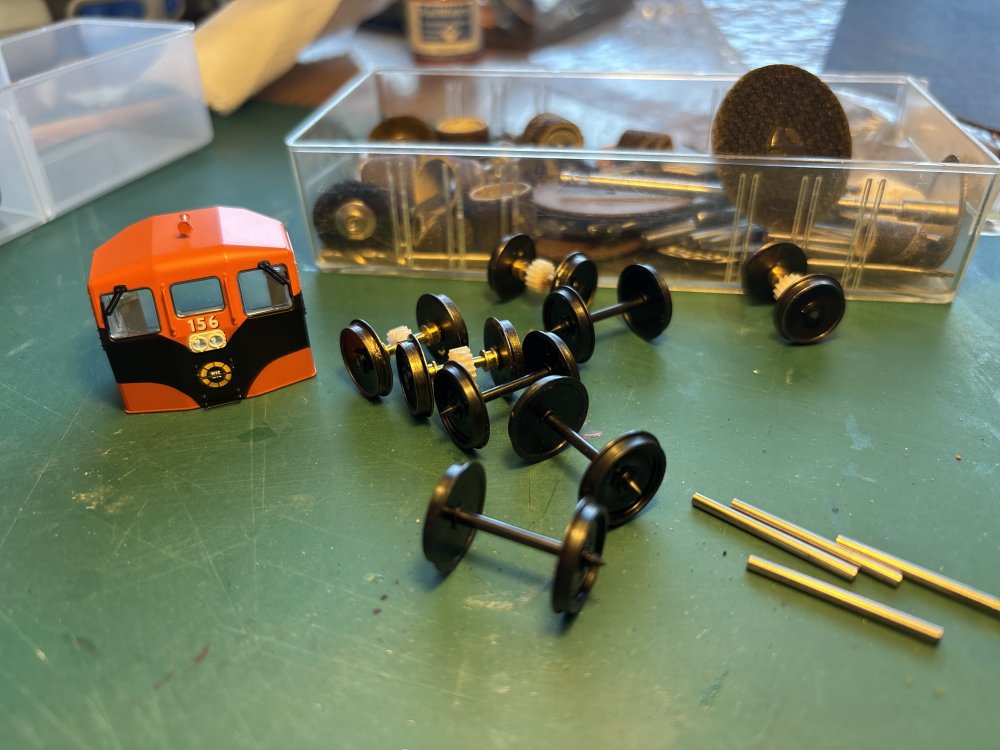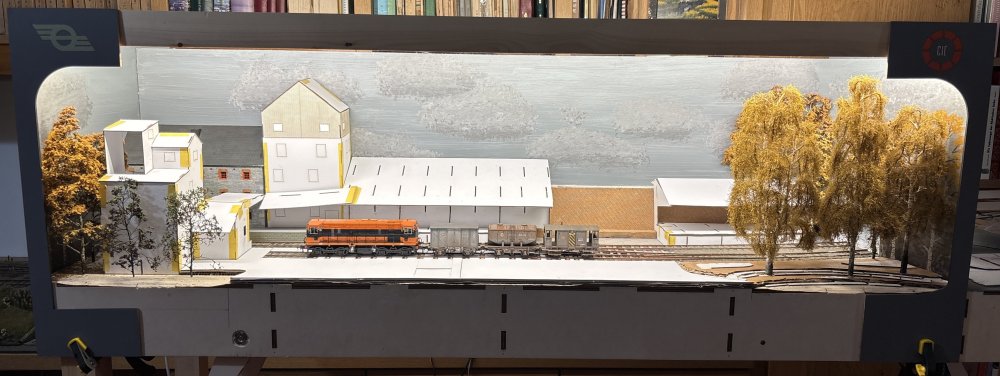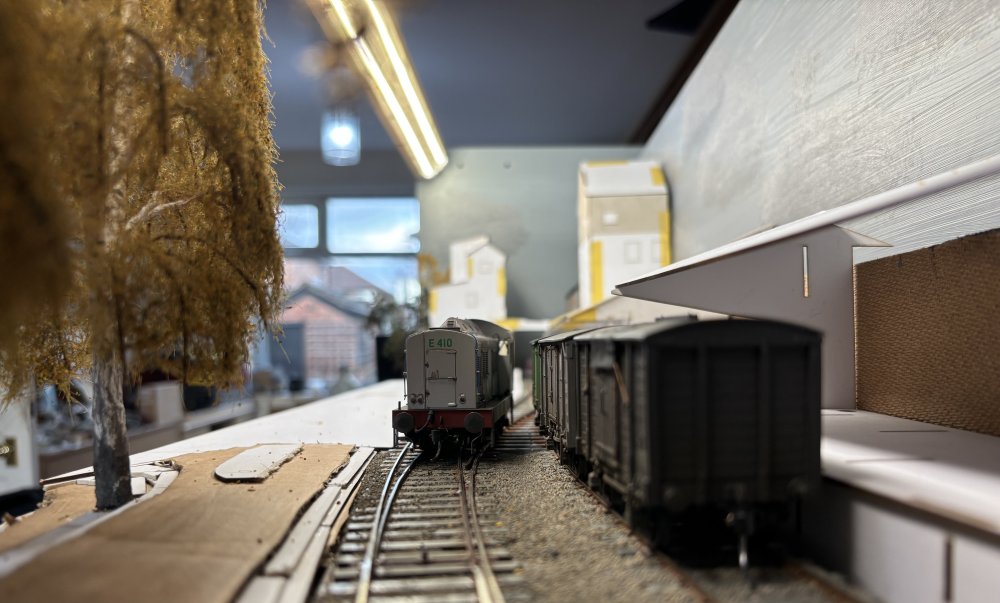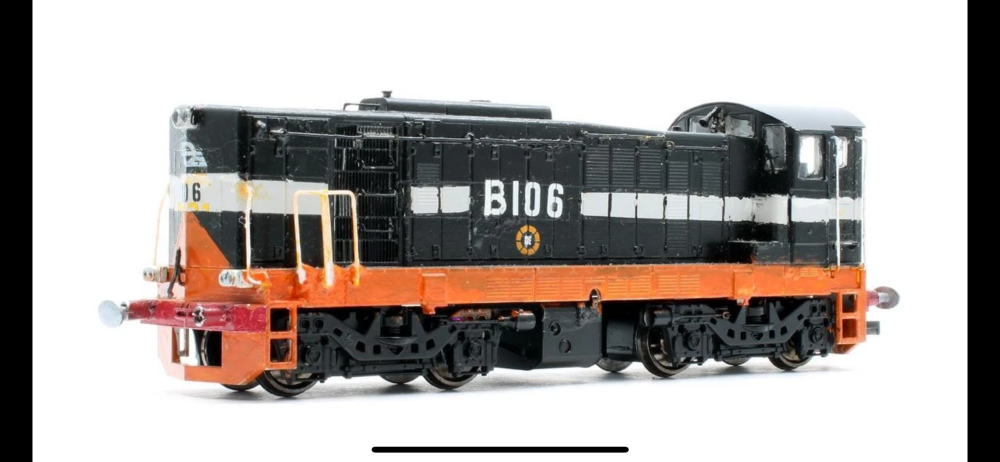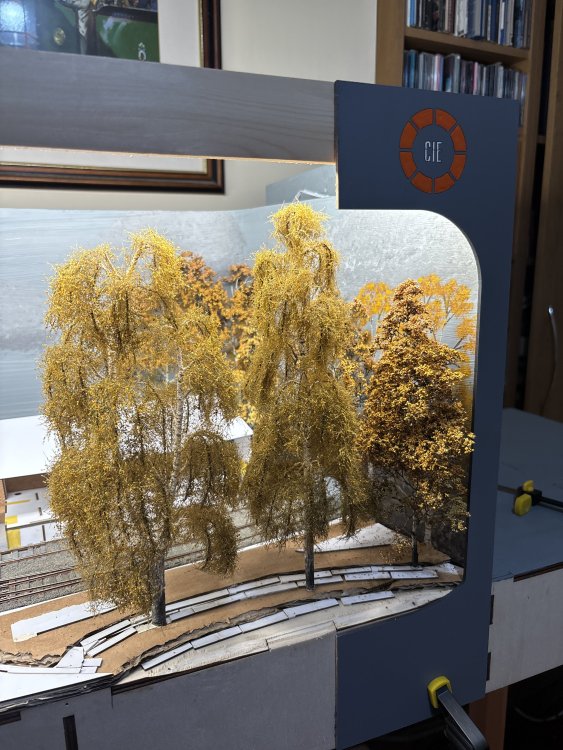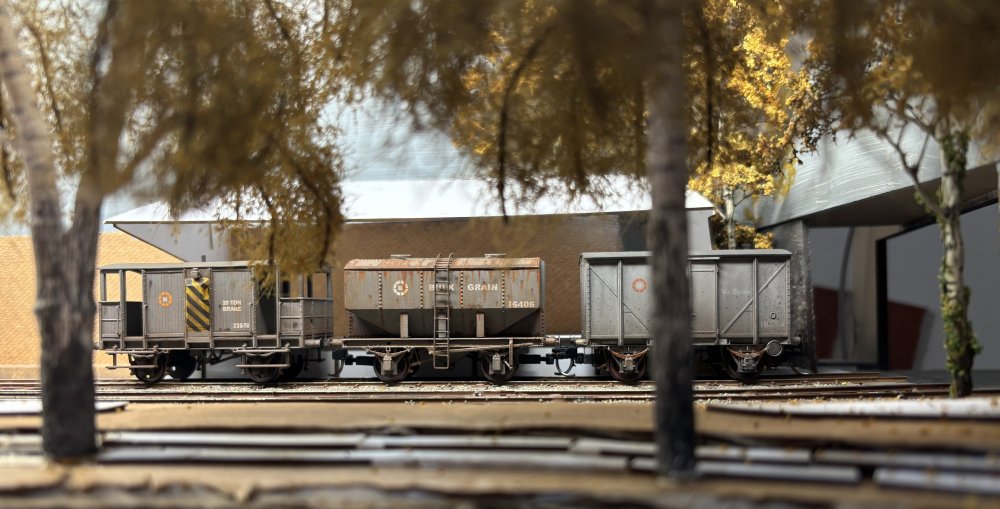
Mol_PMB
Members-
Posts
2,280 -
Joined
-
Last visited
-
Days Won
125
Content Type
Profiles
Forums
Events
Gallery
Everything posted by Mol_PMB
-
Murphy 141 buffer replacement - has anyone done it?
Mol_PMB replied to Mol_PMB's question in Questions & Answers
Many thanks @Rob R I’m using kadees so the buffers are mainly visual. At present I think I will do the buffer swap on this loco and see how it goes. The idea of producing more of these buffers is very appealing! Cheers, Mol -
Murphy 141 buffer replacement - has anyone done it?
Mol_PMB replied to Mol_PMB's question in Questions & Answers
All I can do is apologise. Again. I am sorry. -
"Voiding the Warranty" - Mol's experiments in 21mm gauge
Mol_PMB replied to Mol_PMB's topic in Irish Models
Interesting thought. Years ago I did a bit of Irish O gauge but used the American scale as it was closer to broad gauge. An Atlas switcher on flexicoil trucks had the right style of bogies though not 100% perfect. It looks like the US version of the Flexicoil is now available as a 3D print: https://3dcentraltrains.com/products/51001-flexicoil-p48-emd-truck-atlas-o-upgrade-kit -
"Voiding the Warranty" - Mol's experiments in 21mm gauge
Mol_PMB replied to Mol_PMB's topic in Irish Models
Another warranty voided. A perfectly functional Murphy 141 class now in a million bits. I have removed the cosmetic bogie frames and the fuel tank and started the weathering process on them. Also I removed the wheelsets, dismantled them and reassembled with new longer axles, Gibson carriage wheels and some spacer tubes to keep the wheelsets central. Removing the body was quite an ordeal involving an excess of swearing, but eventually it came apart. I scraped off the old numbers (149) with a cocktail stick, and renumbered it to 156 using some custom transfers I had printed a while ago. In this case, it is correct to have the large shaded numbers on the front. I've also removed the tablet catchers and repainted them, ready to refit. I found that Precision Paints gave a better match to the Murphy orange than Railmatch did. I've started the weathering process on the body, running a dirty wash into the crevices. There's plenty more to do and I'll get the airbrush out tomorrow. I'm aiming for a loco that was recently repainted but has got a bit grubby in traffic and then been well cleaned on the bodysides and ends, but with a grubby roof and bogies, something like this 181 from Ernie: It's interesting that even this pair specially prepared for a royal train still have grubby bogies! 156 ought to have its roundel a bit higher up than the one on the model, and I'm trying to decide whether to scrape them off and add new transfers in the correct place. It's tricky as they are under the handrail. I have some Railtec roundels which are the right size but are very 'orange' - they match the paint. These roundels faded quickly and the printed Murphy models roundels nicely capture the faded colour. Hmm... I have not yet taken the plunge and tackled the buffers. I need to decide whether to hack then off and replace with unsprung, larger ones at the correct spacing. Or live with the ones that are already fitted. I was only able to get one set of the correct type and they're no longer made, so if I do the modification it will be my only 141 with correct buffers. Also I'll need to refit the coupler pockets into the front valance. More tomorrow, hopefully. -
-
Murphy 141 buffer replacement - has anyone done it?
Mol_PMB posted a question in Questions & Answers
With a Murphy 141 on the bench in front of me, I note that the buffers look too close together, and too small. I have a set of Appleby Model Engineering 141 buffers in my stash which are a bit longer and have a bigger face. They look a better match to the prototype. However, they're solid cast metal rather than sprung. Has anyone on the forum tried swapping the buffers and resetting them at the correct spacing? How did you get on? Or is it just me with this level of OCD? Probably! Cheers, Mol (photos from Jonathan Allen and Ernie on Flickr) -
Presumably this was before rolling stock needed different signalling/comms equipment to travel cross-border?
-
"Voiding the Warranty" - Mol's experiments in 21mm gauge
Mol_PMB replied to Mol_PMB's topic in Irish Models
I have spent most of the afternoon having a grand tidy-up and clearing the decks for some holiday projects. As well as more work on the layout I will be working on some rolling stock, as a have quite a stash of things to work through. A little progress on the layout this evening has seen the lighting extended to the fiddle yard, focused on the sector plate areas where I'll need to align the tracks: I have been transplanting a few trees to get the best look. They all slot into holes in the board, so at they stage they can be moved, but once the groundcover is done then they'll be stuck in. Here's a general view of the layout. The end pieces of the fascia have been made and are shown just clamped in place. I still need to do the top and bottom sections: One of the jobs on the list for this week is to regauge the Murphy 141. I'll also fit a decoder and kadee couplers, and renumber it to 156 which is a personal favourite of mine and was also one of the first to receive the supertrain livery. It will be suitable motive power for a bitumen train. And a bitumen tank is another project for this week. Watch this space. This length of train will fit on the sector plate and the loco can also run round it in the loop. It's short but not unrealistically short for this branch, and feels like it's in 'scale' with the layout. If there are already some wagons in the sidings when the train arrives then the shunting could be quite involved. Anything much longer doesn't fit. As an alternative to the 3 wagons, I could also have 2 30' coaches, or 1 bogie coach. When I start thinking about visiting railtours (to add operational variety) then the one real example was a bogie coach and a tin van. Another nice (but fictional) rake to model would be two old 6-wheel coaches and a tin van. To handle those, it would be possible for me to extend the sector plate by 6" or so, overhanging the end of the board. But now I'm thinking too far ahead - I'll leave that to the future if it seems necessary. -
Lovely modelling! Maybe they’re all trying to work out a story to explain the missing crate of beer?
-
This looks very impressive!
-
Now you’re making me thirsty!
-
Or indeed when browsing eBay!
-
"Voiding the Warranty" - Mol's experiments in 21mm gauge
Mol_PMB replied to Mol_PMB's topic in Irish Models
Many thanks for your kind comments! On this layout with a viewing angle across the tracks, I suspect the gauge difference wouldn’t be so obvious. But having to build my own track enables me to choose finer rail profiles, more natural turnout geometry etc, and it all helps. The gauge is more obvious looking along the layout - this is the view from the fiddle yard, which is a similar view to most of the prototype photos I have of this location: -
Here’s a beautiful bargain for @DJ Dangerous to snap up https://ebay.us/m/i93ZFs Yours for just £225 plus postage plus taxes!
-
"Voiding the Warranty" - Mol's experiments in 21mm gauge
Mol_PMB replied to Mol_PMB's topic in Irish Models
I’ve been working on the trees. Finally got all the foliage on the sea moss trees and it was time for a trial fit. Firstly with just the sea moss trees (and the painted ones on the backscene). There are two larger ones in the foreground and 5 smaller ones in the corner: Then adding the two larger Primo trees I bought: They’re pretty good at concealing the hole in the backscene that the trains come through: But if you crouch down a bit you could still see the trains: I may add some more undergrowth to help hide the hole in the sky from this angle. There’s already a tendril of ivy on the tree trunk, ready to spread…- 404 replies
-
- 14
-

-

-

-
The two different types of end lagging.
-
They appear to be in accordance with the diagrams in the GNR wagon diagram book. See also an earlier post: https://irishrailwaymodeller.com/topic/19592-cie-tar-bitumen-tanks-–-the-1950s60s-wagons/#findComment-273196 I have to say they are begging to be modelled! It would be an entirely scratch-built job as there is no suitable tender kit to use as a starting point.
-
I expect they haven't got time to wait for the site to load! It does seem to be having a good moment at present, for me at least. I was about to have to resort to actually doing some modelling rather than just writing about it.
-
Happy days! I have found some photos of the GNR tar tanks! Interestingly, these are both branded UTA (the photos date from 1959 post-split), but were photographed at Inchicore: https://www.flickr.com/photos/irishrailwayarchive/53507104989 https://www.flickr.com/photos/irishrailwayarchive/53507218565
-
I've just been trawling through the IRRS photo archive looking for something else, and found some photos of Dun Laoghaire in the 1950s, where a water tank of this type had been painted as an advertisement for Kingston Shirts. So if you fancied a brighter paint scheme on your water tower then there's a good precedent. The IRRS photos show some good closeups of parts of the lettering: https://www.flickr.com/photos/irishrailwayarchive/53507111269 https://www.flickr.com/photos/irishrailwayarchive/53505868742 https://www.flickr.com/photos/irishrailwayarchive/53507068729 Ernie's views are more distant but show it in glorious colour - bright orange with black and white lettering:
- 37 replies
-
- 1
-

-
- o gauge layout
- irish outline
- (and 2 more)
-
Agreed. IRM is extremely slow, and has been for several days. It works eventually but I keep imagining a dial-up modem chirping away in the background. In comparison, RMweb is running at normal speed.
-
Nice to see the registration plate and number. Many thanks for the images!
-
Rails of Sheffield have some Irish stuff on eBay at the moment - A class, 141s, Genesis coaches, but you won't like the prices!
-
They'll miss my birthday too I'll have to muster all my patience, and get on with building the kit stash. I wonder how the Park Royals are doing?
-
Very nice! I very occasionally see kites overhead, buzzards and kestrels are more common in the skies here in Manchester, and we have a local pair of falcons that I have watched catching pigeons around the M60 Barton viaduct. In the garden I have very good numbers of small birds visiting (tits, finches, sparrows etc) and consequently sparrowhawks also visit my garden. They usually perch on the outbuildings or fences but one hid in the apple tree. We also have parrots nesting locally. They’ll be at it again soon, they breed very early in the year.
.png.c363cdf5c3fb7955cd92a55eb6dbbae0.png)


